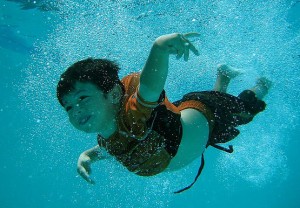How Do Aquatic Animals Maintain Homeostasis While Under Water For So Long?

An otter swims underwater the Detroit, Michigan Zoo (Ellen Meiselman via Flickr/Creative Eatables)
Special properties of an oxygen-bounden poly peptide in the muscles of marine mammals, such as seals, whales and dolphins, are the reason these animals can concur their breath underwater for long periods of time, according to a new study.
Many of these mammalian divers tin can concord their breath underwater for over an hr, while land-based mammals, such as humans, can only practise then for a few minutes at almost.
Scientists from the University of Liverpool, who led the study, were able to identify a unique molecular characteristic of myoglobin, an iron and oxygen-binding protein found in sperm whales and other diving mammals. Until this finding, very little was known about how the molecule is adapted in the diving marine mammals.
The researchers, in collaboration with the University of Manitoba and University of Alaska, found a high concentration of myoglobin, the substance that makes meat look blood-red, in the muscles of the mammalian defined. In fact, the amount was so high in the muscle that it most looked black in color.

Monachus schauinslandi (Hawaiian Monk Seal) underwater at Five Fathom Peak, Hawaii. (Kent Backman via Wikimedia Eatables)
This discovery allowed the scientists to trace the development of how the muscles of more than 100 species of mammals, including fossil remains of their ancient predecessors, were able to shop oxygen.
"We studied the electrical charge on the surface of myoglobin and found that it increased in mammals that can dive underwater for long periods of time," said Dr. Michael Berenbrink, from the University of Liverpool, who led the international team of scientists. "We were surprised when we saw the aforementioned molecular signature in whales and seals, but also in semi-aquatic beavers, muskrats and even water shrews."
Mapping the unique molecular signature of myoglobin throughout the mammalian family tree allowed scientists to recreate the musculus oxygen stores found in the extinct ancestors of today's diving mammals. The team and so was able to find the offset evidence of a common amphibious forefather of modern body of water cows, hyraxes and elephants that lived 65 million years ago in shallow African waters.

While marine mammals like seals, dolphins and whales can stay underwater for long periods of fourth dimension, humans can only do and then for about a minute or so. (gadgetboy32 via Flickr/Creative Commons)
"Our study suggests that the increased electrical charge of myoglobin in mammals that have high concentrations of this protein causes electro-repulsion, like similar poles of two magnets," said Dr. Scott Mirceta, a fellow member of the enquiry team. "This should forestall the proteins from sticking together and permit much college concentrations of the oxygen-storing myoglobin in the muscles of these defined."
The researchers' studies could provide insight into a number of human diseases such every bit Alzheimer's and diabetes, while besides assisting in the development of bogus claret substitutes.
"This finding illustrates the strength of combining molecular, physiological and evolutionary approaches to biological issues and, for the kickoff time, allows us to put 'mankind' onto the basic of these long extinct divers," said Berenbrink.
Lookout a video on this discovery (University of Liverpool/BBSRC)
Source: https://blogs.voanews.com/science-world/2013/06/14/scientists-discover-how-marine-mammals-hold-their-breath-for-long-periods/
Posted by: ellenburgimithe67.blogspot.com

0 Response to "How Do Aquatic Animals Maintain Homeostasis While Under Water For So Long?"
Post a Comment